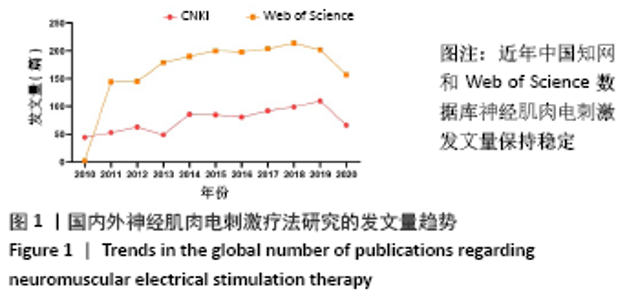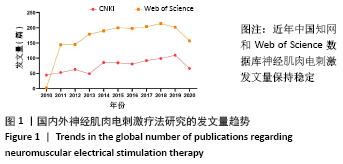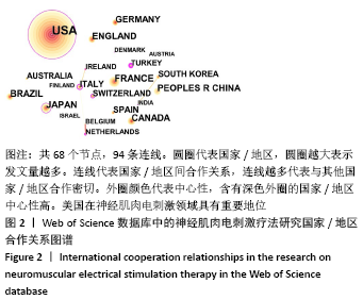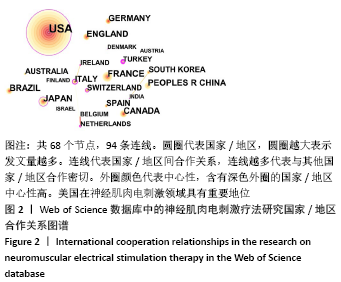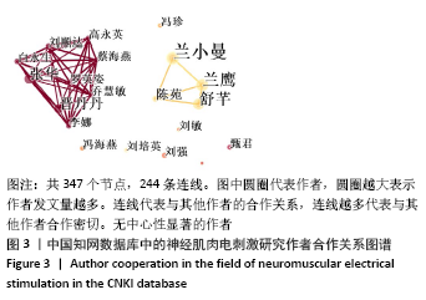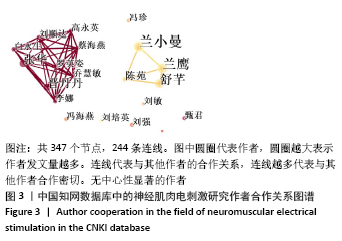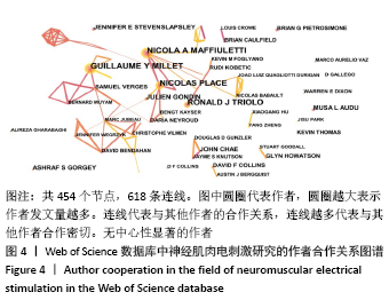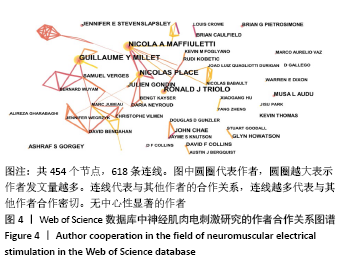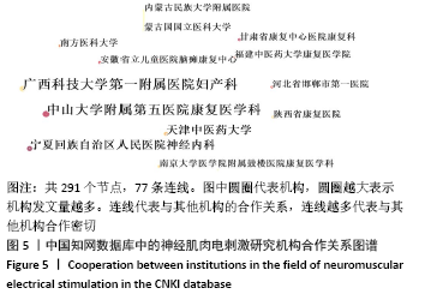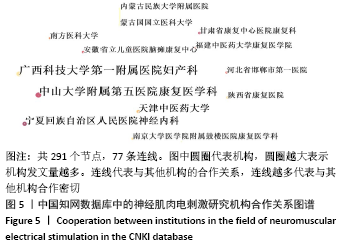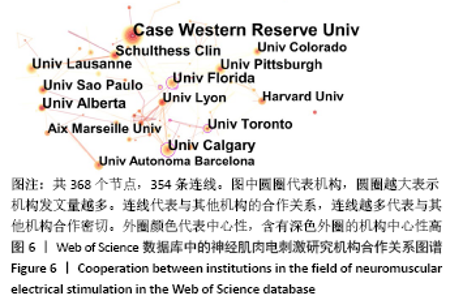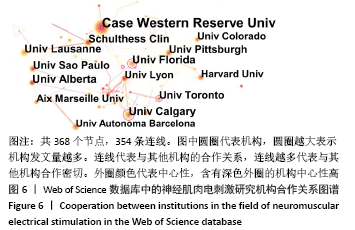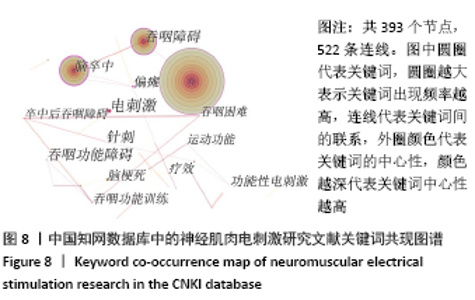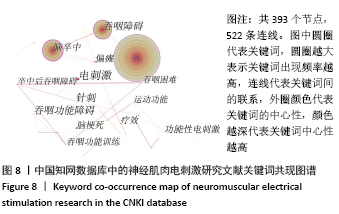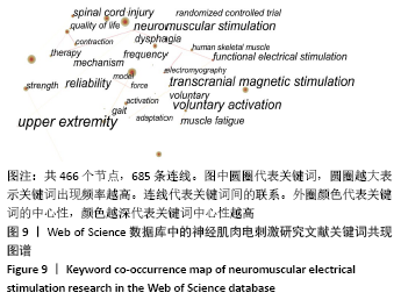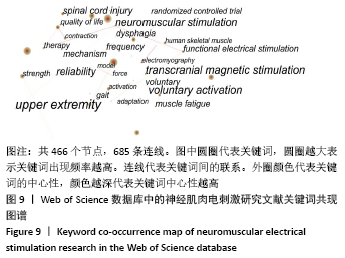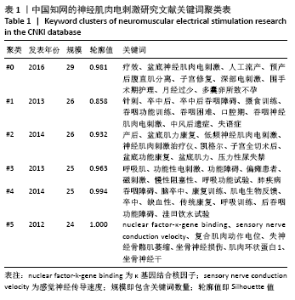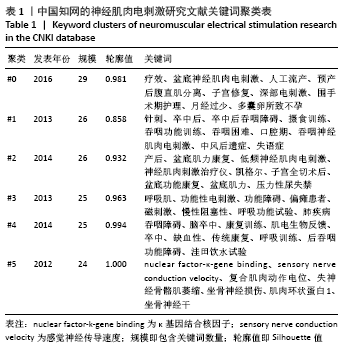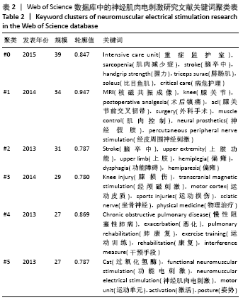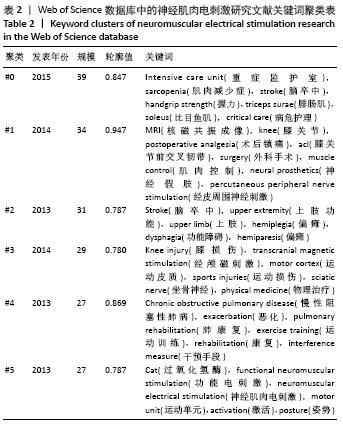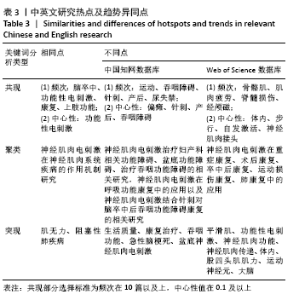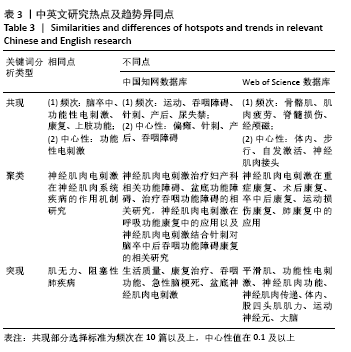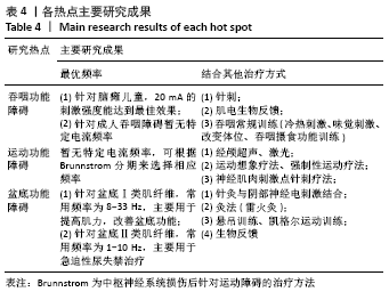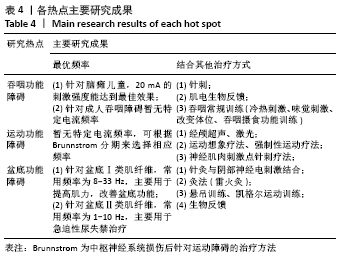Chinese Journal of Tissue Engineering Research ›› 2022, Vol. 26 ›› Issue (8): 1234-1241.doi: 10.12307/2022.229
Previous Articles Next Articles
Visualization analysis of neuromuscular electrical stimulation therapy based on CiteSpace: therapeutic effects, hot spots, and developmental trends
Zhao Jing, Liu Xiaobo, Zhang Yue, Zhang Jiaming, Zhong Dongling, Li Juan, Jin Rongjiang
- School of Health and Rehabilitation, Chengdu University of Traditional Chinese Medicine, Chengdu 610075, Sichuan Province, China
-
Received:2020-11-16Revised:2020-12-08Accepted:2021-01-31Online:2022-03-18Published:2021-11-02 -
Contact:Jin Rongjiang, MD, Professor, Doctoral supervisor, School of Health and Rehabilitation, Chengdu University of Traditional Chinese Medicine, Chengdu 610075, Sichuan Province, China -
About author:Zhao Jing, Master candidate, School of Health and Rehabilitation, Chengdu University of Traditional Chinese Medicine, Chengdu 610075, Sichuan Province, China -
Supported by:the Science and Technology Plan of Sichuan Province, No. 2019YFS0019 (to JRJ)
CLC Number:
Cite this article
Zhao Jing, Liu Xiaobo, Zhang Yue, Zhang Jiaming, Zhong Dongling, Li Juan, Jin Rongjiang. Visualization analysis of neuromuscular electrical stimulation therapy based on CiteSpace: therapeutic effects, hot spots, and developmental trends[J]. Chinese Journal of Tissue Engineering Research, 2022, 26(8): 1234-1241.
share this article
Add to citation manager EndNote|Reference Manager|ProCite|BibTeX|RefWorks
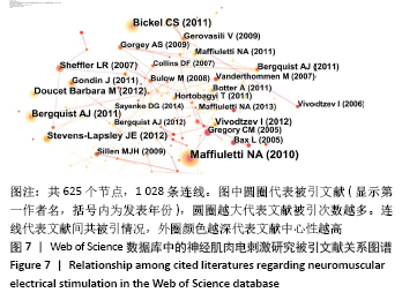
2.5 纳入文献的被引文献的共被引分析 对Web of Science数据库文献进行分析,以被引文献为节点,运行CiteSpace V软件,得到共被引文献图谱,如图7所示。共被引频次第1位的被引文献系统回顾了神经肌肉电刺激疗法的适应证、神经生理学机制及相关影响因素[16];频次第2位的被引文献主要阐述了神经肌肉电刺激通过非选择性、空间交叉和时间同步的电刺激模式招募运动单位来发挥临床疗效的机制[17];频次第3位的被引文献探讨了不同刺激方案(频率、脉冲宽度/持续时间、强度等参数)的神经肌肉电刺激对肌肉骨骼的影响[18];频次第4位的被引文献主要是系统回顾神经肌肉电刺激通过外周通路和中枢通路诱发肌肉收缩的机制以及最佳刺激参数[19];频次第5位的被引文献发现全膝置换后48 h开始进行股四头肌神经肌肉电刺激可以有效减轻股四头肌肌肉损失并改善全膝置换后的功能[20]。频次较高的被引经典文献主要内容是关于神经肌肉电刺激的生理机制以及神经肌肉电刺激在神经肌肉康复中的应用。目前无中心性显著的被引文献。"
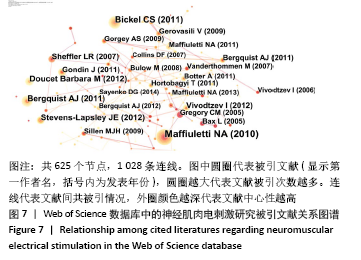
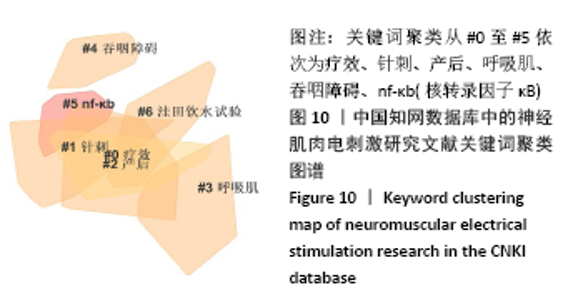
2.6.2 关键词聚类图谱 在关键词共现基础上,通过CiteSpace的LLR算法对关键词聚类,可更清楚地了解到神经肌肉电刺激疗法的主要研究内容[23]。对中国知网数据库文献的关键词进行聚类,可得到7个关键词聚类群标签。如图10所示,Modularity Q值约为0.86,表示聚类结构显著,可清晰界定各个聚类的研究方向;Mean Silhouette值约为0.54,表明聚类间同质性较好。聚类标签中,数字越小,聚类中包含的关键词越多[24]。如表1所示,根据聚类包含的具体关键词总结归纳,可将每个聚类重新命名,总结其研究主题,#0神经肌肉电刺激治疗妇产科相关功能障碍的相关研究、#1神经肌肉电刺激结合针刺对脑卒中后吞咽功能障碍康复的相关研究、#2神经肌肉电刺激治疗盆底功能障碍的相关研究、#3神经肌肉电刺激在呼吸功能康复中的应用、#4神经肌肉电刺激治疗吞咽功能障碍的相关研究、#5神经肌肉电刺激治疗神经系统疾病的临床与机制的相关研究。其中聚类#0、#1、#2、#3、#4归为神经肌肉电刺激针对功能障碍的研究,聚类#5神经肌肉电刺激归为神经肌肉电刺激机制研究。各聚类轮廓值均在0.8以上,说明该聚类相识度高,构成文献主题集中。其中聚类#0集中于2016年,时间距离小且轮廓值高,观察该类文献可以看出神经肌肉电刺激研究主题,针对女性功能康复越来越受到研究者们重视。"
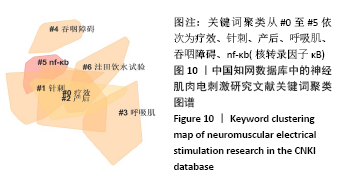
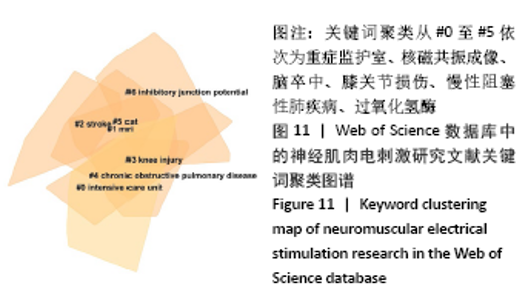
对Web of Science数据库文献的关键词聚类,可得到7个关键词聚类标签。如图11所示,Modularity Q值约为0.77,表示聚类结构显著;Mean Silhouette值约为0.64,表明聚类结果合理。如表2所示,根据聚类中包含的具体关键词总结归纳,可根据其研究主题重新命名,#0神经肌肉电刺激在重症康复中的应用、#1神经肌肉电刺激在术后康复中的应用、#2神经肌肉电刺激在卒中后康复的应用、#3神经肌肉电刺激在运动损伤康复的应用、#4神经肌肉电刺激在肺康复中的应用、#5神经肌肉电刺激在神经肌肉系统疾病的作用机制研究。其中聚类#0、#1、#2、#3、#4可归为神经肌肉电刺激针对某功能障碍的研究,聚类#5归为神经肌肉电刺激机制研究。聚类#1、#2、#3、#4、#5多集中于2013年和2014年,表明神经肌肉电刺激针对术后康复、卒中后康复、运动损伤康复、肺康复以及作用机制是当时研究趋势,而规模最大聚类#0多集中于2015年,表明危重患者的身心康复越来越受到研究者们重视。"
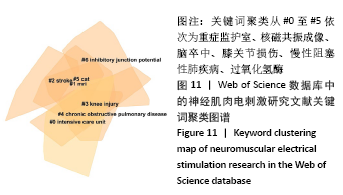
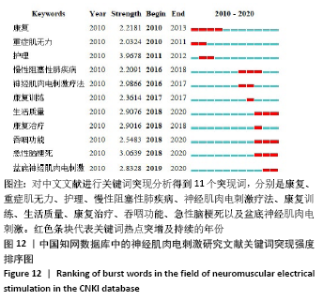
2.6.3 关键词突现分析 以Time zone view显示前沿动态[25],时区视图着重于从时间维度上来表示知识演进,可清晰地展示文献的更新和相互影响[26]。引用突变词(Citation Bursts)是指含该关键词的文献在短时间内被大量引用,可展现本阶段的研究现状,同时反映出后一阶段的研究热点[27]。针对中国知网数据库文献,于关键词聚类基础上选择Time zone view,运行CiteSpace V软件得到时区视图图谱。分析如下:2010-2011年研究内容主要以脑卒中后功能障碍,尤以吞咽功能障碍为主;2011年出现针刺与神经肌肉电刺激结合的研究;2012年开始关注产后康复;2012-2016年主要研究内容以针灸、生活质量为主;2017-2018年开始关注女性生殖相关功能障碍,如会阴瘢痕、月经过少;2019年神经肌肉电刺激领域的临床指南受到重视。突现词分析如图12所示,2010-2013年主要的突现词是康复、重症肌无力、护理;2016-2017年主要的突现词是康复训练、慢性阻塞性肺疾病;2018-2020年主要的突现词是吞咽功能、急性脑梗死、盆底神经肌肉电刺激、生活质量,其中急性脑梗死的强度最大。结合时区视图分析可得,盆底神经肌肉电刺激、脑卒中后功能障碍的研究是近年来的研究热点。"
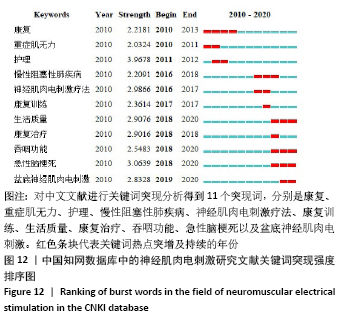
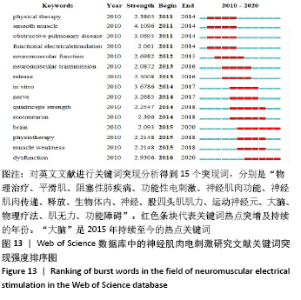
针对Web of Science数据库文献,于关键词聚类基础上选择Time zone view,运行CiteSpace V软件得到时区视图图谱。分析如下:2010-2011年主要研究内容以上肢功能、运动康复为主并注意到儿童群体;2012-2013年研究内容出现假肢与神经肌肉电刺激的研究并开始注意老年群体;2014年主要研究内容针对骨关节炎;2015-2016年出现神经肌肉电刺激结合磁刺激的相关研究;2017-2020年主要研究内容为神经肌肉电刺激对运动产生相关生理机制的影响。突变词分析如图13所示,2011-2014年出现的主要突现词有物理治疗、平滑肌、慢性阻塞性肺疾病、神经肌肉功能、神经肌肉传导、释放,平滑肌的强度最大。2014-2018年出现的主要突现词有离体、神经、股四头肌肌力及运动神经元。2018-2020年出现的主要突现词有大脑、理疗、肌肉无力及功能障碍。"
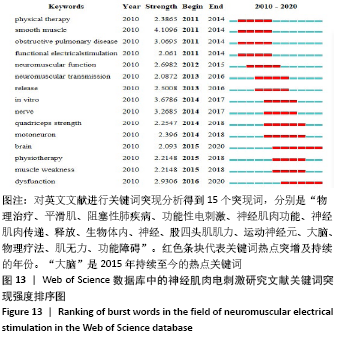
| [1] 杨艳,彭永芳.神经肌肉电刺激联合吞咽功能训练在脑卒中后吞咽功能障碍中的应用价值[J].山西医药杂志,2020,49(11):1385-1387. [2] 丁晓伟,王淑萍,黄英,等.神经肌肉电刺激疗法的临床应用[J].沈阳医学院学报,2014,16(4):234-236. [3] 杨佳佳,徐义明,白跃宏.神经肌肉电刺激预防废用性肌萎缩作用机制及研究进展[J].中国康复,2020,35(3):153-156. [4] 王红.神经肌肉电刺激在脑卒中偏瘫康复治疗中的应用[J].中国医疗器械信息,2019,25(14):56-57. [5] 吴桂焕.神经肌肉电刺激疗法联合吞咽功能训练治疗脑卒中后吞咽障碍的效果[J].中国当代医药,2019,26(36):100-102. [6] 方洪伟,朱浩,王祥瑞.神经肌肉电刺激治疗周围神经损伤的相关研究进展[J].上海医学,2018,41(9):568-571. [7] 王李琴,方景.神经肌肉电刺激联合早期康复训练对关节镜下前交叉韧带重建术后康复的影响[J].实用临床医药杂志,2020,24(17): 110-113. [8] 陈雪梅,贺轶萍,徐维芳.延续性Kegel运动训练联合神经肌肉电刺激对产后盆底肌康复的临床价值[J].临床和实验医学杂志, 2020,19(14):1540-1543. [9] 贾功伟,李娜,殷樱,等.神经肌肉电刺激在慢性阻塞性肺疾病康复中的应用[J].中华物理医学与康复杂志,2017,39(1):21-24. [10] 罗琳,宋乃庆,黄瑾,等.国际儿童动作发展评估研究的回顾与展望:基于CiteSpace可视化分析[J].中国组织工程研究,2021,25(8): 1270-1276. [11] 廖雅娴,何本祥,王纯,等.采用CiteSpace软件对肌腱病研究领域值得关注问题的可视化分析[J].中国组织工程研究,2019,23(23): 3746-3753. [12] 李绍烁,顾一丹,邵阳,等.CiteSpace知识图谱可视化分析中医药防治绝经后骨质疏松症[J].中国组织工程研究,2020,24(26):4224-4230. [13] 王敏,万长秀,田苓华,等.基于CiteSpace的我国运动想象疗法的可视化分析[J].中国医药导报,2020,17(18):28-32. [14] 张建伟,吕韶钧,马晶,等.近10年国内外心脏康复研究现状与热点可视化分析[J].中国循环杂志,2020,35(8):808-814. [15] 曲艺,但文超,崔向宁.基于CNKI的中医药治疗血脂异常知识图谱分析[J/OL].辽宁中医杂志:1-13[2020-12-15]. http://kns.cnki.net/kcms/detail/21.1128.R.20201126.1856.078.html. [16] MAFFIULETTI NA. Physiological and methodological considerations for the use of neuromuscular electrical stimulation. Eur J Appl Physiol. 2010;110(2):223-234. [17] BICKEL CS, GREGORY CM, DEAN JC. Motor unit recruitment during neuromuscular electrical stimulation: a critical appraisal. Eur J Appl Physiol. 2011;111(10):2399-2407. [18] DOUCET BM, LAM A, GRIFFIN L. Neuromuscular electrical stimulation for skeletal muscle function. Yale J Biol Med. 2012;85(2):201-215. [19] BERGQUIST AJ, CLAIR JM, LAGERQUIST O, et al. Neuromuscular electrical stimulation: implications of the electrically evoked sensory volley. Eur J Appl Physiol. 2011;111(10):2409-2426. [20] STEVENS-LAPSLEY JE, BALTER JE, WOLFE P, et al. Early neuromuscular electrical stimulation to improve quadriceps muscle strength after total knee arthroplasty: a randomized controlled trial. Phys Ther. 2012; 92(2):210-226. [21] 陈悦,陈超美,刘则渊,等.CiteSpace知识图谱的方法论功能[J].科学学研究,2015,33(2):242-253. [22] ZHONG D, LUO S, ZHENG L, et al. Epilepsy occurrence and circadian rhythm: a bibliometrics study and visualization analysis via CiteSpace. Front Neurol. 2020;11:984. [23] 李倩,于娱,施琴芬.基于知识图谱的国内外颠覆式创新研究对比分析[J].科技管理研究,2020,40(15):9-19. [24] 陈悦,陈超美,刘则渊,等.CiteSpace知识图谱的方法论功能[J].科学学研究,2015,33(2):242-253. [25] 赵丹群.基于CiteSpace的科学知识图谱绘制若干问题探讨[J].情报理论与实践,2012,35(10):56-58. [26] 刘姬艳.基于CNKI的中医治未病领域载文特点及主题聚类分析[J].中国中医药图书情报杂志,2019,43(3):10-14. [27] 秦义,田元祥.基于CiteSpace的血瘀证证候诊断标准研究的可视化分析[J].世界科学技术-中医药现代化,2015,17(12):2656-2665. [28] 何静,李敏,李程,等.针灸治疗肩周炎的信息可视化技术知识图谱可视化分析[J].世界科学技术-中医药现代化,2019,21(3): 488-494. [29] 兰小曼,兰鹰,舒芊.神经肌肉电刺激治疗产后早期会阴瘢痕疼痛的疗效观察[J].中国实用护理杂志,2018,34(1):5-8. [30] 兰小曼.神经肌肉电刺激联合雷火灸在产后腹部体形恢复治疗中的应用效果[J].广西医学,2020,42(14):1905-1908. [31] 李田,魏亚威,马利.基于CiteSpace的我国中医“治未病”文献知识图谱分析[J].中国中医基础医学杂志,2018,24(11):1526-1529. [32] 赵春合,崔伟曦,孟俊生,等.基于CiteSpace文献计量法的基因组学研究文献可视化图谱分析[J].基因组学与应用生物学,2017, 36(3):1248-1265. [33] 郝文雪,李瑞青,胡延超,等.2010-2019年卒中后认知障碍相关研究的可视化分析[J].中国全科医学,2021,24(6):759-764. [34] 周天雪,李莉娟,冯恩辉,等.头针配合吞咽言语诊治仪治疗卒中后吞咽障碍的临床观察[J].广州中医药大学学报,2017,34(6): 859-863. [35] 刘超,万明珠,黄臻,等.眼针结合神经肌肉电刺激治疗卒中后吞咽障碍的疗效[J].神经损伤与功能重建,2018,13(8):418-419, 423. [36] 邓永政,秦达,杨秀琪.舌三针配合生物电刺激治疗中风后假性球麻痹吞咽障碍的增效观察[J].辽宁中医杂志,2017,44(5):1059-1061. [37] AMANO Y, NOMA T, ETOH S, et al. Reaching exercise for chronic paretic upper extremity after stroke using a novel rehabilitation robot with arm-weight support and concomitant electrical stimulation and vibration: before-and-after feasibility trial. Biomed Eng Online. 2020;19(1):28. [38] YANG YR, MI PL, HUANG SF, et al. Effects of neuromuscular electrical stimulation on gait performance in chronic stroke with inadequate ankle control-A randomized controlled trial. PLoS One. 2018;13(12): e0208609. [39] ELSNER VR, TREVIZOL L, DE LEON I, et al. Therapeutic effectiveness of a single exercise session combined with WalkAide functional electrical stimulation in post-stroke patients: a crossover design study. Neural Regen Res. 2021;16(5):805-812. [40] 吕爱明,李旻,邓文慧,等.中老年女性盆底功能障碍的早期干预治疗[J].中国老年保健医学,2019,17(3):27-29. [41] BORZUOLA R, LABANCA L, MACALUSO A, et al. Modulation of spinal excitability following neuromuscular electrical stimulation superimposed to voluntary contraction. Eur J Appl Physiol. 2020; 120(9):2105-2113. [42] SUNG W, WONG A, POURSHOGI A, et al. Near infrared spectroscopy confirms recruitment of specific lumbar extensors through neuromuscular electrical stimulation. Physiother Theory Pract. 2020; 36(4):516-523. [43] ETOH S, KAWAMURA K, TONAGA K, et al. Effects of concomitant neuromuscular electrical stimulation during repetitive transcranial magnetic stimulation before repetitive facilitation exercise on the hemiparetic hand. NeuroRehabilitation. 2019;45(3):323-329. |
| [1] | Wu Liang, Wang Qiang, Wang Wenbo, Xin Tianwen, Xi Kun, Tang Jincheng, Xu Jingzhi, Chen Liang, Gu Yong. Risk factors for traumatic central cord syndrome underlying with cervical spondylotic myelopathy [J]. Chinese Journal of Tissue Engineering Research, 2022, 26(9): 1388-1394. |
| [2] | Li Zhiyi, He Pengcheng, Bian Tianyue, Xiao Yuxia, Gao Lu, Liu Huasheng. Bibliometric and visualized analysis of ferroptosis mechanism research [J]. Chinese Journal of Tissue Engineering Research, 2022, 26(8): 1202-1209. |
| [3] | Tang Wenjing, Wu Siyuan, Yang Chen, Tao Xi. Inflammatory responses in post-stroke depression [J]. Chinese Journal of Tissue Engineering Research, 2022, 26(8): 1278-1285. |
| [4] | Fang Xiaolei, Leng Jun, Zhang Chen, Liu Huimin, Guo Wen. Systematic evaluation of different therapeutic effects of mesenchymal stem cell transplantation in the treatment of ischemic stroke [J]. Chinese Journal of Tissue Engineering Research, 2022, 26(7): 1085-1092. |
| [5] | Yan Nan, Wu Yanlong, Tang Xiaohui, Zhang Xiaoyan, Wang Hui, Yang Tianze, Zhou Maochun, Wang Zhengdong, Yang Xiaoxia. Bone marrow mesenchymal stem cells may alleviate brain damage caused by the microglial overactivation in the cortex around ischemic site of stroke [J]. Chinese Journal of Tissue Engineering Research, 2022, 26(24): 3790-3795. |
| [6] | Chen Na, Wang Xiaohan, Zhang Yunke. Effect and mechanism of mesenchymal stem cells on aging-related ischemic stroke [J]. Chinese Journal of Tissue Engineering Research, 2022, 26(24): 3914-3920. |
| [7] | Xiakeerzhati•Xiaohalati, Wang Xiaobei, Wang Lin. Nanoparticles: a novel strategy for the treatment of ischemic stroke [J]. Chinese Journal of Tissue Engineering Research, 2022, 26(22): 3566-3572. |
| [8] | Li Shulun, Hao Peng, Hao Fei, Duan Hongmei, Zhao Wen, Gao Yudan, Yang Chaoyang, Li Xiaoguang. Pathological changes in rats with ischemic stroke induced by improved photochemical embolization [J]. Chinese Journal of Tissue Engineering Research, 2022, 26(2): 218-224. |
| [9] | Dong Jiale, Wei Yuanhao, Zhang Hongwu. Visualization analysis of bone defect treatment based on knowledge map [J]. Chinese Journal of Tissue Engineering Research, 2022, 26(18): 2906-2913. |
| [10] | Yang Yanwen, Zhang Jing, Mao Yuling, Ni Jun, Mao Libin, Yao Lu, Wang Huiying, Liu Qiuming, Ma Zhenzhen. Establishment of a severe heatstroke pig model under high-temperature and high-humidity environment [J]. Chinese Journal of Tissue Engineering Research, 2022, 26(17): 2678-2684. |
| [11] | Xiao Xiang, Huang Dongfeng. Virtual reality training improves motor function of the upper limbs in stroke survivors: an evaluation using transcranial magnetic stimulation [J]. Chinese Journal of Tissue Engineering Research, 2022, 26(17): 2756-2761. |
| [12] | Chen Keyi, Wang Dingxuan, Zhao Sike, Xia Zhangrong. Research hotspots of pressure training in rehabilitation and visualized analysis of relevant literature data in the past 10 years [J]. Chinese Journal of Tissue Engineering Research, 2022, 26(15): 2406-2411. |
| [13] | Li Zhishuai, Zhang Hongqian, Li Li, Han Xinwen, Feng Jing. Finite element analysis of the knee joint: research hotspots and trends [J]. Chinese Journal of Tissue Engineering Research, 2022, 26(15): 2412-2418. |
| [14] | Liao Yingying, Zhang Xin, Wen Chenghong, Chen Ke, Zhou Hui, Gou Qingchun. Animal models of knee joint stiffness: modeling methods and characteristics [J]. Chinese Journal of Tissue Engineering Research, 2022, 26(15): 2439-2445. |
| [15] | Xue Xiali, Deng Zhongyi, Sun Junzhi, Li Ning, Ren Wenbo, Zhou Ling, He Ye. Hot spots and frontiers of rehabilitation robot research in recent 10 years: a bibliometric analysis based on the Web of Science database [J]. Chinese Journal of Tissue Engineering Research, 2022, 26(14): 2214-2222. |
| Viewed | ||||||
|
Full text |
|
|||||
|
Abstract |
|
|||||
